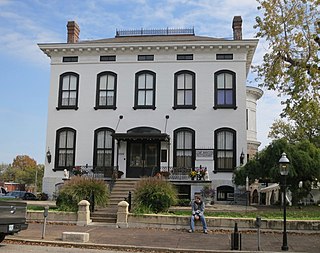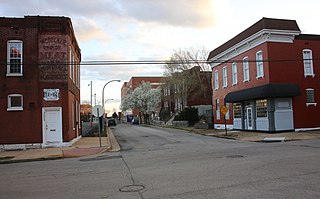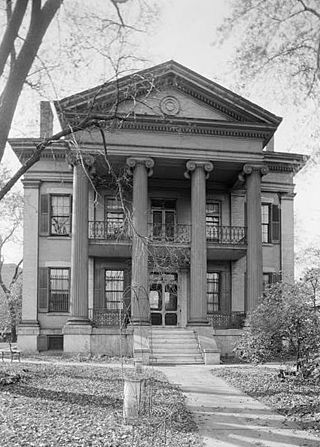
Pilsner is a type of pale lager. It takes its name from the Bohemian city of Plzeň, where the world's first pale lager was produced in 1842 by Pilsner Urquell Brewery.

Pale lager is a pale-to-golden lager beer with a well-attenuated body and a varying degree of noble hop bitterness.

Adolphus Busch was the German-born co-founder of Anheuser-Busch with his father-in-law, Eberhard Anheuser. He introduced numerous innovations, building the success of the company in the late 19th and early 20th centuries. He became a philanthropist, using some of his wealth for education and humanitarian needs. His great-great-grandson, August Busch IV, is a former CEO of Anheuser-Busch.
Steam beer, also known as California common beer, is made by fermenting lager yeast at a higher than normal temperature.

In the United States, beer is manufactured in breweries which range in size from industry giants to brew pubs and microbreweries. The United States produced 196 million barrels (23.0 GL) of beer in 2012, and consumes roughly 28 US gallons (110 L) of beer per capita annually. In 2011, the United States was ranked fifteenth in the world in per capita consumption, while total consumption was second only to China.

Wrexham Lager is a lager brewed in Wrexham, north-east Wales, tracing its heritage to 1881. After the original brewery's closure in 2000, the brand was revived by the Roberts family in 2011 using an older recipe.

The Lemp Mansion is a historical house in Benton Park, St. Louis, Missouri. It is also the site of three suicides by Lemp family members after the death of the son Frederick Lemp, whose William J. Lemp Brewing Co. dominated the St. Louis beer market before Prohibition with its Falstaff beer brand. The mansion is said to be haunted by members of the Lemp family.

Onondaga Cave State Park is a Missouri state park located on the Meramec River approximately 5 miles (8.0 km) southeast of the village of Leasburg. The park was established in 1982. Park activities include cave tours, camping, fishing, hiking, picnicking, and swimming.

The Lemp Brewery was a beer brewing company established in 1840 in St. Louis, Missouri that was acquired by the Griesedieck Beverage Company in 1920, which subsequently became the Falstaff Brewing Corporation. The brewery complex property consists of 27 buildings on a 13.7-acre (0.055 km2) site in the Marine Villa neighborhood. St. Louisian Steve DeBellis has been the owner of the Lemp Brewing Company trademark since 1988.

The Falstaff Brewing Corporation was an American brewery located in St. Louis, Missouri. With roots in the 1838 Lemp Brewery of St. Louis, the company was renamed after the Shakespearean character Sir John Falstaff in 1903. Production peaked in 1965 with 7,010,218 barrels brewed and then dropped 70 percent in the next 10 years. While its smaller labels linger on today, its main label Falstaff Beer went out of production in 2005. The rights to the brand are owned by Pabst Brewing Company.

Benton Park is a neighborhood in southside St. Louis, Missouri, just west of the Soulard neighborhood. The official boundaries of the area are Gravois Avenue on the north, Cherokee Street on the south, I-55 on the east, and Jefferson Avenue on the west. Benton Park is unrelated to Benton Place, a private street located in Lafayette Square, St. Louis.

Marine Villa is a neighborhood of St. Louis, Missouri. The neighborhood is located just south of the large and historic Anheuser-Busch Brewery complex along the bluffs of the Mississippi River. It is further defined by Cherokee Street's Antique Row on the north, Gasconade Street on the south, South Broadway and Jefferson Avenue on the west, and the Mississippi River on the east.

Lager is a type of beer brewed and conditioned at low temperature. Lagers can be pale, amber, or dark. Pale lager is the most widely consumed and commercially available style of beer. The term "lager" comes from the German word for "storage", as the beer was stored before drinking, traditionally in the same cool caves in which it was fermented.

The Chatillon–DeMenil Mansion, located at 3352 DeMenil Place in Benton Park, St. Louis, Missouri, was begun in 1848 for the pioneer Henry Chatillon, then enlarged to its present form by prominent St. Louis businessman Nicolas DeMenil from 1855 to 1863. The house serves as a house museum, and according to its nomination to the National Register of Historic Places, described "as being the finest example of Greek Revival architecture in the Midwest."

Detroit Beer Co. is a brewpub located on Broadway Street in downtown Detroit, Michigan, United States. Detroit Beer Co. opened in the fall of 2003 and is part of a trio of local breweries, including the Royal Oak Brewery (1995) and the Rochester Mills Beer Co. (1998). The Detroit Beer Co. was launched by Drew Ciora and Mike Pelsz, who purchased and renovated the historical Hartz building at a cost of $5.3 million. The Hartz Building was an early 20th-century surgical supply store and was renovated to accommodate a restaurant, brewery equipment, office space, and a loft apartment. It is within close proximity to the sports stadiums Comerica Park and Ford Field.

The Schmidt Artist Lofts is a historic former brewery for Schmidt Brewery. It is located in the West Seventh neighborhood of Saint Paul, Minnesota, United States. The building was vacant for 11 years until a massive community and developer effort resulted in a plan for a revitalization of the brewery's historic building into the creation of the Schmidt Artist Lofts in 2013.

The Jacob Schmidt Brewing Company is a former brewing company that was located at 882 W. Seventh Street in Saint Paul, Minnesota. Founded in 1855, the brewery was originally known as the Christopher Stahlmann Cave Brewery.
The Caves of Faribault is an artisan cheese company headquartered in Faribault, Minnesota as a division of Swiss Valley Farms. Utilizing sandstone caves to age cheese, the company makes a variety of raw milk products, including several styles of blue cheese, Gouda, and cheddar.
Cherokee Street is a culturally significant east-west street in South City, St. Louis, Missouri. Its western border is Grand Boulevard and its eastern border is Broadway.


















